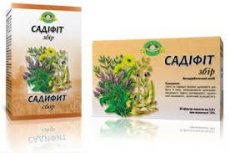Medical expert of the article
New publications
Preparations
Sadifit
Last reviewed: 03.07.2025

All iLive content is medically reviewed or fact checked to ensure as much factual accuracy as possible.
We have strict sourcing guidelines and only link to reputable media sites, academic research institutions and, whenever possible, medically peer reviewed studies. Note that the numbers in parentheses ([1], [2], etc.) are clickable links to these studies.
If you feel that any of our content is inaccurate, out-of-date, or otherwise questionable, please select it and press Ctrl + Enter.

Sadifit is a herbal medicine and is included in the group of antidiabetic therapeutic drugs. The composition of the drug Sadifit includes: blueberry leaves, pods of common beans, Jerusalem artichoke tubers, stevia leaves, peppermint leaves, green leaf tea.
Indications Sadifit
Indications for the use of the drug Sadifit are diseases such as diabetes mellitus type II (insulin-independent) mild to moderate, chronic cholecystitis, chronic pancreatitis, enterocolitis.
 [ 1 ]
[ 1 ]
Release form
Release form: a collection of medicinal plants in 75 g packs and a collection in the form of coarse powder in filter bags of 3 g (in a package of 20 pieces).
Pharmacodynamics
The therapeutic effect of Sadifit is due to the ability of biologically active substances of the indicated medicinal plants to positively influence carbohydrate metabolism in the body, glucose synthesis in the liver and the process of insulin secretion from pancreatic cells.
Jerusalem artichoke tubers and blueberry leaves included in the collection contain inulin - an organic substance from the group of polysaccharides, which has high biological activity aimed at regulating carbohydrate-fat metabolism and preventing energy deficiency in diabetes. If glucose ceases to be absorbed by the body of a patient with type II diabetes, inulin is able to replace it.
The pods of common beans contain a large amount of the conditionally essential amino acid arginine (2-amino-5-guanidinopentanoic acid), which has an insulin-like effect on metabolism in patients with diabetes.
Stevia is a natural sugar substitute. Of the eight dipertene glycosides contained in stevia leaves, the sweetest are stevioside and rebaudioside - 150-300 times sweeter than sucrose with negligible caloric content. Stevioside reduces the level of glucose and cholesterol in the blood. In diabetes, it prevents the development of both hypoglycemia (low blood sugar) and hyperglycemia (high blood sugar), which allows you to significantly reduce the dose of insulin or antidiabetic drugs taken orally.
In addition, stevia contains amino acids, microelements, minerals, pectins, tannins, vitamins and antioxidants, which help restore metabolism in the body, stimulate the digestive organs, liver and pancreas.
Sadifit helps to reduce the concentration of low-density lipoproteins (LDL) in the blood, which is significantly increased in diabetes. Thus, the drug improves the elasticity of the vessel walls and reduces the risk of atherosclerosis. In addition, Sadifit has a pronounced anti-inflammatory and choleretic effect.
Pharmacokinetics
The manufacturer has not provided data on the pharmacokinetics of Sadifit.
Dosing and administration
The infusion is prepared at the rate of 1 tablespoon of Sadifit per 1.5 cups (300 ml) of water. Pour the herbal mixture into an enamel container, add hot boiled water, cover the container with a lid and place in a water bath for 15 minutes from the moment it boils. After cooling, strain the decoction, squeeze the remainder into the resulting decoction. Replenish the volume of the decoction to 300 ml by adding boiled water.
Take the decoction warm (shake before use), 30 minutes before meals. The dosage of Sadifit for adults is half a glass 3 times a day for 20-30 days. The dosage for children is determined depending on age - from 2 tablespoons to 70 ml (a third of a glass) three times a day.
Method of application and dosage of the preparation in filter bags: place two filter bags in a thermos, pour 300 ml of boiling water, close and leave for an hour. The dosage of the infusion for adults and children is similar to the dosage of the decoction.
After 20-30 days of treatment with Sadifit, it is recommended to take a break for 7-10 days and then repeat the course of treatment.
Use Sadifit during pregnancy
The use of Sadifit during pregnancy is prohibited.
Contraindications
A contraindication to the use of this drug is increased individual sensitivity to biologically active substances of plant origin that are part of the drug.
 [ 2 ]
[ 2 ]
Side effects Sadifit
No side effects of Sadifit have been identified.
 [ 3 ]
[ 3 ]
Overdose
Overdose of Sadifit has not been recorded.
 [ 4 ]
[ 4 ]
Interactions with other drugs
The interaction of Sadifit with other drugs has not been studied.
 [ 5 ]
[ 5 ]
Shelf life
The shelf life of the herbal collection in a sealed package is 2 years.
Attention!
To simplify the perception of information, this instruction for use of the drug "Sadifit" translated and presented in a special form on the basis of the official instructions for medical use of the drug. Before use read the annotation that came directly to medicines.
Description provided for informational purposes and is not a guide to self-healing. The need for this drug, the purpose of the treatment regimen, methods and dose of the drug is determined solely by the attending physician. Self-medication is dangerous for your health.

